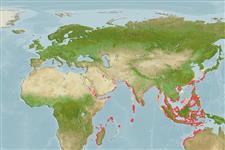Preferred temperature (Ref.
115969): 25.3 - 29, mean 28.5 (based on 1946 cells).
Phylogenetic diversity index (Ref.
82804): PD
50 = 0.7500 [Uniqueness, from 0.5 = low to 2.0 = high].
Bayesian length-weight: a=0.00389 (0.00316 - 0.00479), b=3.05 (3.00 - 3.10), in cm Total Length, based on LWR estimates for this species (Ref.
93245).
栄養段階 (Ref.
69278): 3.8 ±0.4 se; based on diet studies.
回復力 (Ref.
120179): 非常に低い, 14年以上の倍増期間の最小個体群 (K=0.88; tm=2; tmax=6; Fec=1).
Fishing Vulnerability (Ref.
59153): Moderate to high vulnerability (46 of 100).
